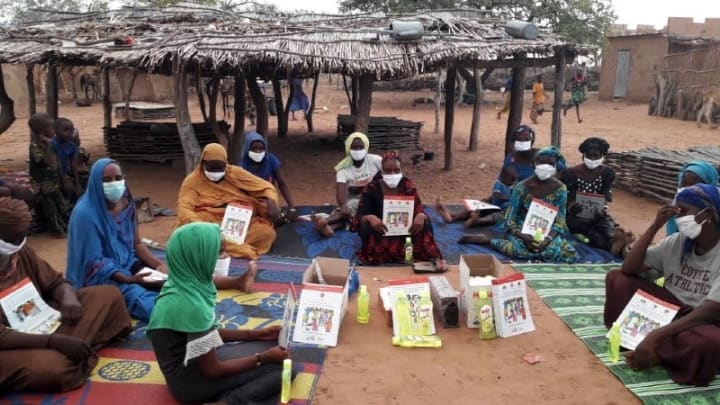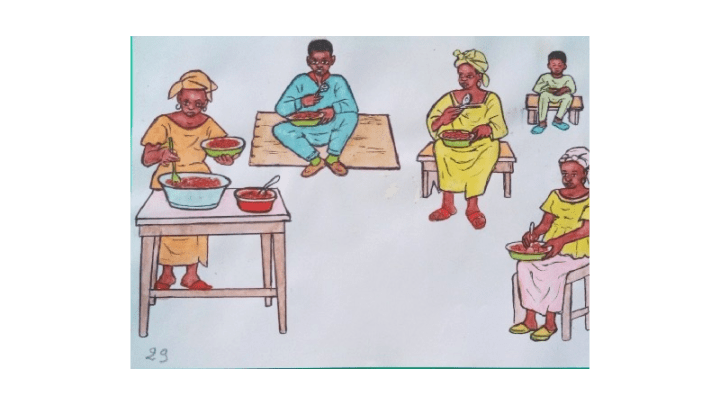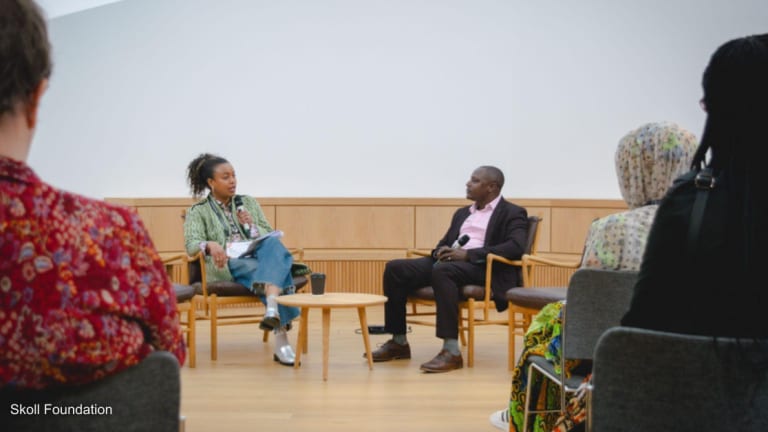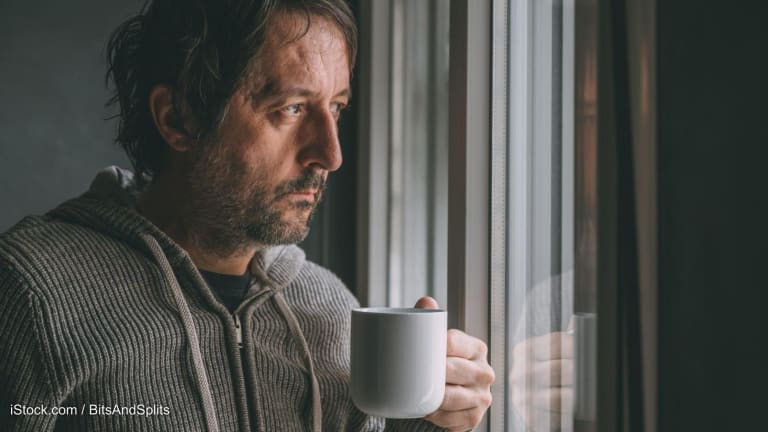
COVID-19 has crystallized the importance of sharing health information that is tailored to local contexts and translated into local languages, according to Molly Melching, founder and creative director of Tostan, an organization working to empower women and girls through nonformal education.
While the messages around COVID-19 prevention are universal — frequently wash hands, social distance, and wear a mask — Melching believes the way they are shared can have an impact on their uptake.
“Providing the information in national languages and adapted to the realities and social norms of people in rural communities has been so important,” she said, adding that what may be possible in terms of COVID-19 prevention and social norms in an urban context may look different in more remote settings.
At the start of the outbreak, Tostan developed a brochure with key COVID-19 prevention messages. Illustrations depicted local housing, practices, and dress and advice was tailored to address any social norms that may be affected by the virus.
For example, Melching explained that in many West African communities it is commonplace to eat from the same bowl. After consultation with the communities, the brochure included an alternative practice conducive to mitigating the spread of COVID-19.
“It's so important to always work with the communities, listen to them, ask them what, for them, are the alternative solutions so that they can actually implement the preventative measures,” Melching advised.
Produced in nine African languages as well as in French, English, and Portuguese, Tostan has so far distributed 59,500 books in five African countries and is in the process of scaling.
“We always keep in mind the cultural practices, social norms, and values of the community, including, of course, their religious beliefs.”
— Molly Melching, founder and creative director, TostanSpeaking to Devex, Melching shared the lessons the pandemic has taught Tostan about the value of context-specific education and offered her advice for other organizations wanting to have a greater impact with their awareness-raising messaging.
This conversation has been edited for length and clarity.
Tostan has over 30 years experience in changing social norms. How important is it to support shifts in knowledge and behaviors to ensure successful national response and prevention strategies to COVID-19?
When COVID broke out, I was really upset to see there was nothing on the internet or anywhere — [no] brochures, booklets, informational documents — that really portrayed the realities of rural life. We immediately decided we needed to work on this and developed a brochure to show what the realities are; that is that they don't have running water, they don't have faucets.

We [depicted] what people are doing in order to be able to wash their hands, explaining that it's really important to wash with soap for 20 seconds because that is what kills the coronavirus [and] providing drawings that illustrate the text.
Then we addressed social norms. For example, it’s important that people eat together out of the same bowl in a lot of the countries where we work so we called the communities — as well as the supervisors and facilitators who work for Tostan in the communities — and asked them “what is the solution?” They said: “We could eat individually. We could put the food in the large bowl, but then each person could have their own plate in order to avoid transmission of the germs through eating together or even drinking out of the same cup together, which are both our normal practices.”
In Tostan’s experience, what have been the most effective ways in shifting knowledge during COVID-19?
The cultural side is so important and it's one of the reasons Tostan has been successful over the years. We always keep in mind the cultural practices, social norms, and values of the community, including, of course, their religious beliefs.
In fact, the second brochure we developed was on an Islamic perspective of pandemics. This was important because people were protesting, for example, the fact that mosques were being closed. We worked on this brochure with our Islamic rights specialist as Islam is the major religion in the countries where we work.
All of the measures for prevention that are recommended by the government are actually addressed in the Koran. Imam Diop thus included verses from the Koran that correspond to the coronavirus preventive measures. This was very important.
In fact, today, I received a WhatsApp message from a community imam to say he was using this brochure and it was so helpful for him to have the verses from the Koran to explain to people that it’s OK for them to pray at home and not necessarily go to the mosque — or that it was OK to pray outside, and also find other ways to greet people.
The two brochures our team developed have been widely used on Tostan’s weekly local radio programs to bring this information to an even larger audience in rural areas.
What advice would you give to other organizations looking to disseminate key information amid COVID-19?
First of all, they are welcome to go to www.tostan.org and download our two open source brochures in different languages and use or adapt them for communities where they work. We really want to help prevent the spread of COVID-19 in rural Africa by making these brochures as available as possible.
If organizations are going to develop their own materials for rural populations, I think the most important thing is to be sure to listen carefully to people to understand what, for them, could be alternative practices to the harmful ones.
If a social norm is involved, it means that it's something that is an expected behavior and has social value to people. It is therefore hard to stop norms such as greeting by shaking hands. So it is important to ask them “What, for you, are the best alternatives we should promote?”
We also tried to avoid giving what I call outside-in messages such as “Do this! Don’t do that!” Rather, we presented information in a way that shows we are all in this initiative together.
Also I would advise people to make sure they get feedback on illustrations before finalizing printed or digital information.
I’ll tell you a funny story: Our artist wanted to depict people in quarantine to accompany the text “If someone gets COVID-19 or has symptoms, they will need to be isolated.” The drawing showed people in four separate empty rooms. When I sent the drawing to the villagers, they responded by saying, “Oh yes, these people are using a latrine.” It was the boxes that made it seem like they were sitting, standing, or coming out of a latrine. So of course we had to redo the drawings with furniture in the four rooms so that they could better visualize what quarantine would look like in a village setting.




